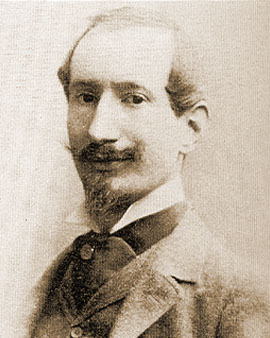


Achille Beltrame (1871-1945) was born when Italy had just become a united state - and he died when megalomania had ended in Italy's deepest shame. As eventful as the times were in and for Italy - in Beltrame they had an illustrious illustrator, a "chronicler with brush and pencil".
Beltramo was born in 1871 in Arzignano, a town in the province of Vicenza not far from Venice. He was educated in Brera - the Milan district that is generally considered synonymous with the "Accademia di belle Arti" there - by Giuseppe Bertini. But unlike Bertini, whose frescoes and altarpieces were mainly devoted to classical historical and religious themes, Beltrame was more concerned with the present. The young draughtsman made his journeyman's play from 1896 as an employee of the "Casa Ricordi" - the renowned music publisher from Milan that had made the great opera compositions accessible to the general public by means of music books. Beltrane's drawings (including postcards) were a real eye-catcher, as we would say today.
This is how Luigi Albertini, the young publisher of the influential liberal Milanese daily newspaper "Corriere della sera", became aware of him. Especially at the turn of the century illustrated (Sunday) supplements in daily newspapers became popular, and Albertini entrusted Beltrane with the design of his "Domenico del Corriere". Beltrane stayed until 1941, during which time he created over four thousand colour drawings. Until the advent of press photos, this was often the only way to visualize concrete events. Among Beltrane's drawings are "The Assassination of Sarajevo" (which was to lead to World War I in 1914), "The Tricolour about Trieste" (this city was awarded to Italy as the victor of the 1919 war from the bankruptcy assets of Austria-Hungary), but also a massive drawing by the fascist "Duce", Benito Mussolini, from 1936.
At that time Beltranes boss was no longer called Luigi Albertini. In 1922 he had emphatically opposed a takeover by the fascists and had to leave the country in 1925. Beltrane stayed and continued his work until he handed over his office to Walter Molino in 1941. By this time Mussolini had already involved his country in the Second World War, which was to end in a chain of humiliating defeats and lead to the conquest and partial devastation of Italy. Moreno by the way drew for the "Domenico del Corriere" until about 1970. This is apparently no different in Italy than anywhere else in the world: politicians, parties and editors may come and go, but a good illustrator survives them all. Achille Beltrano died in Milan on February 19, 1945, at the age of almost 74. His drawings made him immortal in Italy.

Achille Beltrame (1871-1945) was born when Italy had just become a united state - and he died when megalomania had ended in Italy's deepest shame. As eventful as the times were in and for Italy - in Beltrame they had an illustrious illustrator, a "chronicler with brush and pencil".
Beltramo was born in 1871 in Arzignano, a town in the province of Vicenza not far from Venice. He was educated in Brera - the Milan district that is generally considered synonymous with the "Accademia di belle Arti" there - by Giuseppe Bertini. But unlike Bertini, whose frescoes and altarpieces were mainly devoted to classical historical and religious themes, Beltrame was more concerned with the present. The young draughtsman made his journeyman's play from 1896 as an employee of the "Casa Ricordi" - the renowned music publisher from Milan that had made the great opera compositions accessible to the general public by means of music books. Beltrane's drawings (including postcards) were a real eye-catcher, as we would say today.
This is how Luigi Albertini, the young publisher of the influential liberal Milanese daily newspaper "Corriere della sera", became aware of him. Especially at the turn of the century illustrated (Sunday) supplements in daily newspapers became popular, and Albertini entrusted Beltrane with the design of his "Domenico del Corriere". Beltrane stayed until 1941, during which time he created over four thousand colour drawings. Until the advent of press photos, this was often the only way to visualize concrete events. Among Beltrane's drawings are "The Assassination of Sarajevo" (which was to lead to World War I in 1914), "The Tricolour about Trieste" (this city was awarded to Italy as the victor of the 1919 war from the bankruptcy assets of Austria-Hungary), but also a massive drawing by the fascist "Duce", Benito Mussolini, from 1936.
At that time Beltranes boss was no longer called Luigi Albertini. In 1922 he had emphatically opposed a takeover by the fascists and had to leave the country in 1925. Beltrane stayed and continued his work until he handed over his office to Walter Molino in 1941. By this time Mussolini had already involved his country in the Second World War, which was to end in a chain of humiliating defeats and lead to the conquest and partial devastation of Italy. Moreno by the way drew for the "Domenico del Corriere" until about 1970. This is apparently no different in Italy than anywhere else in the world: politicians, parties and editors may come and go, but a good illustrator survives them all. Achille Beltrano died in Milan on February 19, 1945, at the age of almost 74. His drawings made him immortal in Italy.
Page 1 / 47






